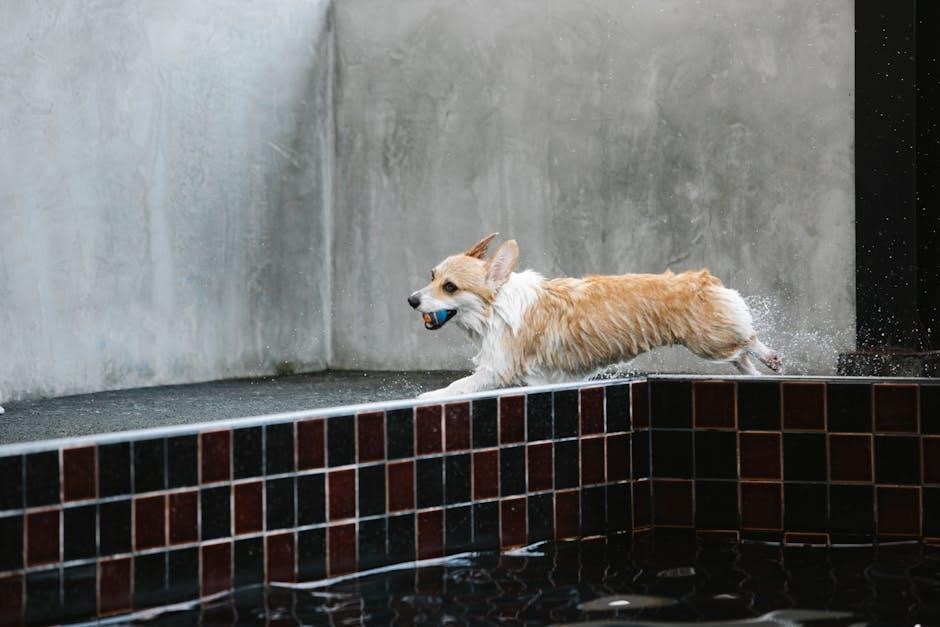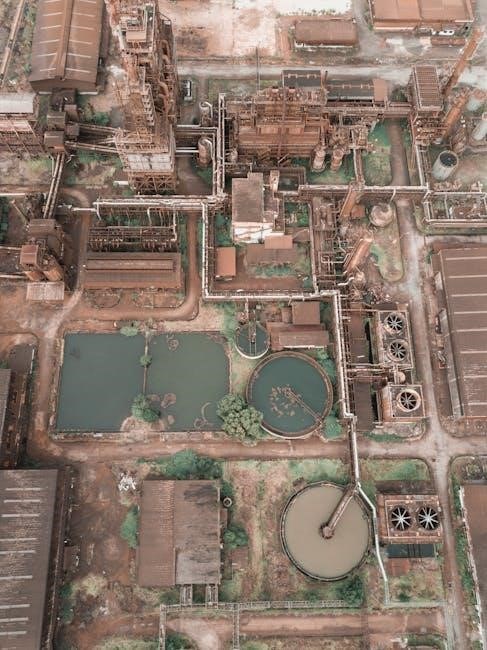
pool filter sizing guide
Proper pool filter sizing is crucial for maintaining clear water and efficient circulation. This guide helps you choose the right filter based on pool volume, flow rate, and turnover time, ensuring optimal performance.
1.1 Why Proper Sizing Matters
Proper pool filter sizing is essential for maintaining clear water, efficient circulation, and optimal pump performance. An undersized filter may struggle to handle the pool’s volume, leading to poor water clarity and increased chemical demand. Conversely, an oversized filter can be unnecessarily expensive and may not operate efficiently. Correct sizing ensures the filter can manage the pool’s turnover rate, removing contaminants effectively while maintaining consistent water flow. This balance is critical for keeping your pool clean, reducing maintenance, and prolonging equipment lifespan. Improper sizing can lead to frequent backwashing, higher energy costs, and potential damage to the filtration system. Accurate sizing ensures a healthier pool environment and lower operational costs.
1.2 Overview of Key Factors
The key factors in pool filter sizing include pool volume, shape, and turnover rate. Pool volume is calculated based on shape: rectangular pools use length × width × depth, while round and kidney-shaped pools require specific formulas. Turnover rate, the time to cycle all pool water, influences filter capacity. Flow rate, determined by pump size and pool volume, must match the filter’s capacity to prevent inefficiency. Filter types (sand, cartridge, DE) vary in efficiency and maintenance needs. Surface area and volume ratios, like 100 sq. ft. per 10,000 gallons for cartridge filters, guide sizing. Larger or high-usage pools may need larger filters. These elements ensure optimal performance, efficiency, and water clarity.

Calculating Pool Volume
Pool volume is calculated based on shape and dimensions. For rectangular pools, use length × width × average depth × 7.5. Round pools require π × (diameter/2)^2 × average depth × 7.5. Kidney-shaped pools use length × width × average depth × 7.5. These formulas help determine gallons of water, crucial for proper filter sizing and efficient circulation.
2.1 Formula for Rectangular Pools
For rectangular pools, the volume in gallons is calculated using the formula:
[ ext{Volume (gallons)} = ext{Length (ft)} imes ext{Width (ft)} imes ext{Average Depth (ft)} imes 7.5 ]
This formula accounts for the pool’s dimensions and converts cubic feet to gallons. Measure the pool’s length, width, and average depth accurately. Multiply these values together, then by 7.5 to get the total gallons. This calculation is essential for determining the correct filter size and ensuring proper water circulation. Accurate volume measurement ensures the filter can handle the water effectively, avoiding undersized or oversized systems. Proper sizing maintains clear water and optimal pump performance.
2.2 Formula for Round Pools
For round pools, the volume in gallons is calculated using the formula:
[ Volume (gallons) = π × (Diameter/2)² × Average Depth (ft) × 7.5 ]
This formula accounts for the pool’s circular shape by incorporating the diameter and average depth. Measure the pool’s diameter and average depth accurately. Square the radius (diameter divided by 2), multiply by π, then by the average depth, and finally by 7.5 to convert cubic feet to gallons. Accurate volume calculation is critical for selecting the right filter size, ensuring proper water circulation and clarity. Proper sizing prevents inefficient filtration and maintains optimal water quality.
2.3 Formula for Kidney-Shaped Pools
Kidney-shaped pools require a specific formula to calculate volume due to their irregular shape. Measure the longest width, shortest width, and length. Use the formula:
[ Volume (gallons) = π × (Longest Width/2) × (Shortest Width/2) × Length × Average Depth × 7.5 ]
This formula approximates the volume by treating the pool as an oval shape. Ensure accurate measurements, as irregular shapes can lead to miscalculations. Multiply the longest and shortest widths, divide each by 2, then multiply by length, average depth, and 7.5 to convert cubic feet to gallons. Precise volume calculation is essential for proper filter sizing and efficient water circulation. Avoid undersizing the filter to maintain water clarity and system performance.
Determining Pump Turnover Rate
Turnover rate is the time needed for the pump to circulate the entire pool volume. Calculate it by dividing pool volume by pump flow rate in GPM. Aim for 2-3 turnovers daily for clean water and optimal circulation efficiency, adjusting based on pool usage and specific features.
3.1 Understanding Turnover Rate
Turnover rate refers to the time required for the pump to circulate the entire volume of pool water. It is a critical factor in maintaining water clarity and circulation efficiency. A proper turnover rate ensures chemicals are evenly distributed and prevents algae growth. The turnover rate is calculated by dividing the pool volume by the pump’s flow rate in gallons per minute (GPM). Typically, pools require a turnover rate of 2-6 hours, depending on usage patterns. Higher turnover rates are recommended for pools with heavy use or unique features like waterfalls. Understanding turnover rate helps balance filter size and pump capacity for optimal performance.
3.2 Calculating Turnover Rate
To calculate the turnover rate, divide the pool volume (in gallons) by the pump’s flow rate (in gallons per minute, or GPM). This gives the time in minutes required to circulate the entire pool volume. Convert minutes to hours by dividing by 60. For example, a 20,000-gallon pool with a pump flowing at 80 GPM has a turnover rate of 20,000 ÷ 80 = 250 minutes, or approximately 4.17 hours. Accurate measurements of pool volume and pump flow are essential for correct calculations. The turnover rate helps determine if the pump and filter system can maintain clean, safe water based on usage demands and pool size.
Determining Filter Flow Rate
The filter flow rate must match the pump’s output to ensure efficient water circulation. Calculate it using pool volume and turnover rate to maintain clean, safe water.
4.1 Relationship Between Pump and Filter
The pump and filter must work in harmony to ensure efficient water circulation. The pump pushes water through the filter, which removes contaminants. For optimal performance, the filter flow rate should match the pump’s output. If the filter is undersized, it can’t handle the pump’s flow, leading to poor water quality. Conversely, a filter that’s too large may not be cost-effective. The turnover rate, which determines how often water circulates, is a key factor in sizing both components. Balancing these elements ensures clean, safe water and reduces energy consumption. Proper alignment avoids inefficiencies and potential damage to equipment.
4.2 Calculating Filter Flow Rate
To calculate the filter flow rate, divide the pool’s volume by the desired turnover time. The formula is: Flow Rate (GPM) = Pool Volume (gallons) ÷ Turnover Time (hours). For example, a 18,000-gallon pool with a 6-hour turnover time requires a flow rate of 50 GPM. This ensures the filter can handle the water effectively. The flow rate must align with both the pump’s output and the filter’s capacity. A higher flow rate may require a larger filter. Always check the manufacturer’s specifications to ensure compatibility. Proper calculation prevents inefficiency and maintains clean water. Adjustments may be needed for unique pool configurations or heavy usage.

Selecting the Right Pool Filter Type
Choosing the right pool filter type depends on your pool’s size, volume, and usage. Sand, cartridge, and DE filters each offer unique benefits for different pool needs.
5.1 Sand Filters
Sand filters are a popular choice for pool filtration due to their cost-effectiveness and simplicity. They work by trapping dirt and debris as water passes through layers of sand. For optimal performance, sand filters should have a minimum of 100 sq. ft. of surface area per 10,000 gallons of pool water. They are ideal for small to medium-sized pools and require regular backwashing to maintain efficiency. Sand typically needs replacement every 5-7 years, depending on usage. Sand filters are reliable and easy to maintain, making them a practical option for many pool owners.
5.2 Cartridge Filters
Cartridge filters are known for their high efficiency and ease of maintenance. They use replaceable cartridges to trap dirt and debris, providing cleaner water with less resistance. A good rule of thumb is to ensure at least 100 sq. ft. of filter surface area per 10,000 gallons of pool water. Cartridge filters are ideal for larger pools, especially inground pools over 25,000 gallons. They require less frequent cleaning compared to sand filters but need cartridge replacement every 2-5 years. Their compact design and superior filtration make them a preferred choice for pool owners seeking balance between performance and convenience.
5.3 DE (Diatomaceous Earth) Filters
DE filters are highly efficient, using diatomaceous earth powder to trap particles as small as 2-5 microns. They offer superior water clarity and are effective against algae and contaminants. When sizing a DE filter, consider the pool’s volume and desired turnover rate. A smaller DE filter may suffice due to its high efficiency, but regular maintenance is crucial. After backwashing, the filter must be recharged with fresh DE powder. While they provide excellent filtration, the need for frequent recharging and potential mess can be a downside. DE filters are ideal for pool owners prioritizing water quality and willing to handle the maintenance requirements.

Pool Filter Size Based on Surface Area and Volume
Pool filter size depends on surface area and volume. Manufacturers provide sizing charts based on these factors. Proper sizing ensures efficient water circulation and clarity.
6.1 Minimum Surface Area Requirements
Meeting minimum surface area requirements ensures efficient filtration. For cartridge filters, a rule of thumb is 100 sq. ft. of surface area per 10,000 gallons of pool water. Larger pools or those with unique shapes may require additional surface area to maintain proper water clarity. The surface area must also align with the pump’s flow rate to avoid overloading the filter. Neglecting these requirements can lead to poor water quality and increased maintenance. Always consult manufacturer guidelines for specific recommendations tailored to your pool’s size and type; Proper surface area ensures optimal performance and extends the life of your filtration system.
6.2 Volume-to-Filter Size Ratio
The volume-to-filter size ratio is critical for ensuring your pool water remains clean and clear. A general rule is to ensure at least 100 square feet of filter surface area for every 10,000 gallons of pool water. This ratio helps maintain proper water circulation and filtration efficiency. For example, a 20,000-gallon pool requires at least 200 square feet of filter surface area. Sand filters typically require more surface area compared to cartridge or DE filters. Neglecting this ratio can lead to poor water quality and increased maintenance. Always match your filter size to your pool’s volume to ensure optimal performance and extend the life of your filtration system.

Adjusting Filter Size for Special Cases
Adjusting filter size is essential for special cases, such as larger pools or high-usage scenarios. Consider pool size, usage patterns, and water features to avoid undersized filters, which can lead to poor water quality. Upsizing may be necessary for optimal performance in these situations.
7.1 Larger Pools
Larger pools require upsized filters to handle increased water volume and flow rates. For pools exceeding 25,000 gallons, consider increasing filter surface area by 25-50% to maintain efficiency. Undersized filters can struggle to circulate water effectively, leading to poor clarity and chemical distribution. Ensure the filter can manage the pool’s maximum turnover rate, especially if the pool features waterfalls, jets, or high bather loads. Proper sizing ensures optimal performance, energy efficiency, and clean water quality for larger pools.
7.2 High Usage Pools
High usage pools, such as those in hotels or community centers, require larger filters to handle increased contamination from multiple users. To ensure clean water, consider upsizing the filter by 30-50% compared to standard recommendations. This accounts for higher dirt and debris intake, which can overwhelm a smaller system. Undersized filters may struggle to maintain clarity and circulation, leading to poor water quality and increased chemical demand. Regular maintenance and cartridge replacements are also crucial for high traffic pools to keep the system efficient. Proper sizing ensures the filter can manage the additional load, providing consistent performance and a safe swimming environment for all users.
Proper pool filter sizing is essential for maintaining clean, safe, and energy-efficient swimming conditions. By calculating pool volume, turnover rate, and flow rate, you can select the right filter type and size. Factors like pool shape, surface area, and usage patterns also play a critical role. High-usage pools and larger pools may require upsizing filters for optimal performance. Always consider manufacturer guidelines and consult professionals if unsure. A well-sized filter ensures clear water, reduces maintenance, and prolongs equipment lifespan. Investing time in accurate calculations and selections will lead to long-term benefits for your pool’s health and functionality.